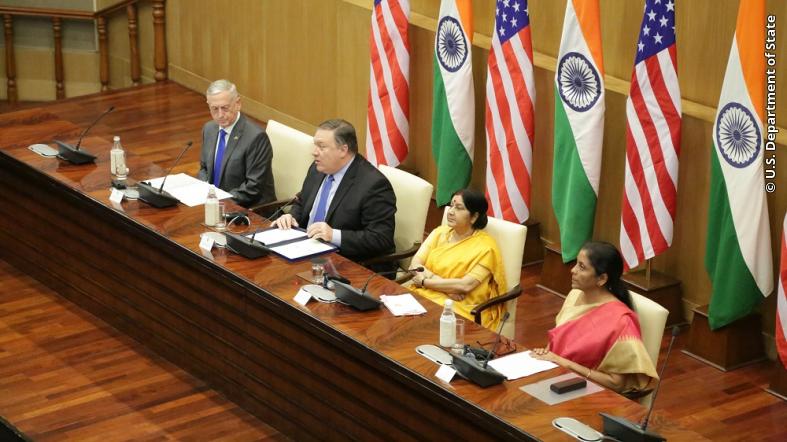The 'Indo-Pacific' in India-US relations
- By Sajjad Malik
 0 Comment(s)
0 Comment(s) Print
Print E-mail China.org.cn, September 16, 2018
E-mail China.org.cn, September 16, 2018

Top Indian and U.S. defence and foreign policy officials last week held the inaugural session of the much-hyped "2 plus 2" dialogue in New Delhi. It has further strengthened their bilateral relations and streamlined the ongoing consultations to cultivate closer strategic ties through a structured and institutional process.
After going through the joint statement, issued at the end of the meeting, and the statement of India's External Affairs Minister Sushma Swaraj, the compelling conclusion one comes across is that from the U.S. perspective, the growing security relationship is about how to checkmate China in the Asia-Pacific region by actively engaging India and encouraging it to play a role.
The Pacific region is quite important for the U.S. due to a variety of reasons. Rightly it has been trying to bring together more partners and supporters to bolster its position. India has shown a willingness to become part of this arrangement, as it not only provides an opportunity to access the latest Western defense technologies, but also an opportunity to share a platform with world powers.
An interesting concept – also a terminology – of the "Indo-Pacific" has been added to the vocabulary of international relations and strategic politics. Though not entirely new, as the term has been used to denote the confluence of the Pacific and Indian oceans, the U.S. has changed its meaning by making it a point of reference for greater regional geo-political considerations.
The term Indo-Pacific has been more frequently employed by the Trump administration. His predecessor Barack Obama, despite having a soft spot for India, often preferred to use the term Asia-Pacific. Obama and Modi also used the "Asia-Pacific" in their joint statements in 2014 and 2015.
The 2017 National Security Strategy of the Trump administration describes the Indo-Pacific as a region where "a geopolitical competition between free and repressive visions of world order is taking place" and where allegedly "China is using economic inducements and penalties, influence operations, and implied military threats to persuade other states to heed its political and security agenda."
Here enters the idea of "freedom of seas and skies" vis-à-vis the Indo-Pacific. This concept is closely linked with China due to the South China Sea issue. By creating a perception of fear, India is being propped up as a regional power having legitimate security and economic interest in the Indo-Pacific region.
Secretary of State Mike Pompeo, after the "2 plus 2" dialogue, said that, "India and the United States have a natural starting point for advancing a free and open Indo-Pacific."
U.S. policy towards China is becoming clearer. On the one hand, tariffs are being imposed to offset the economic development and exports of China, and on the other hand it is being portrayed as a disruptive rising power that can threaten the free flow of trade and other commercial activities in the Indo-Pacific region.
The U.S. unease is understandable due to the challenges of the 21st century. But why is India entangling itself in the tricky regional power game? Traditionally, India maintained its non-aligned stance which served it well, though it suffered due to a lack of access to the latest military hardware from the West.
The obligations of having a security alliance with the U.S. are often cumbersome and India might not be able to shoulder the burden. So, despite being drawn in to the inner circle of the U.S. system of allies, India will have to highlight the red lines – otherwise it will be soon thrown into the vortex of unnecessary conflicts from the Middle East to the Far East.
India, being one of the fastest growing economies, cannot afford any kind of conflict. It needs a long period of peace for uninterrupted progress to reclaim its true position in the world and also to uplift millions of impoverished people.
Indo-Pacific politics will get murkier in the long run, as the U.S. will try to offset the rise of China by all means, including pursuing the policy of containment. It may not be able to catch up China in the economic field but it can slow down its progress by creating roadblocks.
India's long-term interest lies in having good ties with both China and the U.S. and not moving closer to one at the cost of ties with the other. It will have to avoid the lure of the "Indo-Pacific."
Sajjad Malik is a columnist with China.org.cn. For more information please visit:
http://www.china.org.cn/opinion/SajjadMalik.htm
Opinion articles reflect the views of their authors, not necessarily those of China.org.cn.






Go to Forum >>0 Comment(s)